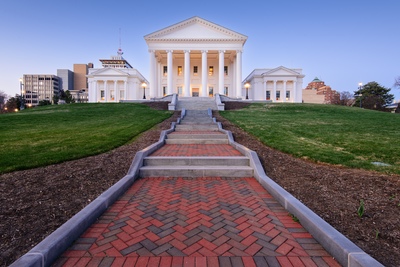
Elections & Campaigns
Election Update: Democrats Sweep Key States in Reversal from 2021 Elections
November 5, 2025 | Bill Kramer
November 4, 2020 | Bill Kramer, Lauren Doroghazi
-1ddcc0-1200px.jpeg)
Key Takeaways:
For updated state elections results, maps, and analysis, visit the MultiState 2020 State Elections Coverage landing page and our 2020 Elections Dashboard.
The theme for state races in the 2020 elections so far is that Republicans have held, if not expanded, their lead in state governments (both governors and legislatures). Democrats had very high expectations going into the elections, but the gubernatorial map was never great for them and they underperformed in state legislative races in states they hoped to flip control away from Republicans.
There were no big surprises in the races for governor this year. With only 11 gubernatorial elections in 2020, forecasters pinned nine of the races as safe for the incumbent party with only one close race forecasted in Montana to replace term-limited Democrat Steve Bullock. In that race, Republican Greg Gianforte defeated Democrat Mike Cooney to flip the Montana governor’s mansion for Republicans. Democrat Roy Cooper held on to the governor's mansion in North Carolina and Republicans Mike Parson and Jim Justice did the same in Missouri and West Virginia, respectively.
Republicans have gained one gubernatorial seat after the 2020 elections by flipping the open seat in Montana. In 2021, Republicans will have 27 governors and Democrats will have 23 governors.

Hopes were high for Democrats in the 5,877 state legislative races in 2020. Forecasters put nine legislative chambers currently under Republican control as potentially flipping to Democratic control after the elections. However, the elections were a huge disappointment as it appears Democrats will fail to flip most of these state legislative chambers. Democrats failed to take advantage of opportunities to gain control of the Iowa House, Michigan House, Pennsylvania House, Texas House, and both the House and Senate in North Carolina. As results are still being tabulated in close races, Democrats still have a path of gaining control in the Minnesota Senate and both the House and Senate in Arizona.
Adding to the good news for Republicans, the GOP will flip control in the New Hampshire Senate from Democrats and are likely to break up the current coalition in the Alaska House, giving control of the chamber to Republicans in 2021. So a year where Democrats expected big gains in the state legislatures might net them one or no chambers and could even add to the Republican’s current lead of 59 state legislative chambers nationwide to Democrats’ 39 chambers. We’ll keep you updated as close races are called over the coming days.
Pre-election, Republicans held supermajorities in 30 chambers and Democrats held supermajorities in 20. State legislative results are still being called for close races, so we don’t have a clear picture of many changes to supermajorities quite yet. We do know that Democrats have gained a supermajority in the Delaware Senate. Additionally, Republicans have held their supermajorities in the Kansas House and Senate.
When one party controls both the legislature and governor’s mansion in a state (a "trifecta"), that party has a clear path to pass preferred public policies without any major roadblocks from the opposition party. Pre-election, Republicans held trifectas in 21 states, Democrats held 15 state trifectas, and the remaining 14 states were under split control.
As results of the November 3 elections come rolling in, Republicans have picked up a trifecta in Montana by winning the open gubernatorial race to replace the term-limited Democratic governor. In Alaska, Republicans may have gained enough seats to wrest control of the House from the coalition of Democrats, Independents, and moderate Republicans currently in charge. However, we won’t know for sure until next year if a new coalition is formed or if Republicans will take formal control of the chamber (in 2018, Republicans appeared to have secured control by winning a majority of seats until a few moderate Republicans helped form the coalition).
Democrats were hoping to break up a number of Republican trifectas by capturing control of several Republican state legislative chambers. But those hopes were dashed with a strong showing by Republican candidates in state legislative races. Democrats failed to take advantage of opportunities in the Iowa House and the Texas House, which would have broken up Republican trifectas in those states. Democrats still have a chance to break up the Republican trifecta in Arizona if they can gain control of either the Arizona House or Senate, which is still too close to call.
Democrats’ best chance of picking up a trifecta in the 2020 elections was to capture the Minnesota Senate from Republican control. But that chamber is currently too close to call.
Unsurprisingly, marijuana legalization ballot measures passed unanimously on election night. Voters in Arizona, Montana, New Jersey, and South Dakota approved measures to legalize recreational marijuana, while measures to legalize medical marijuana also passed in Mississippi and South Dakota. After the elections, fifteen states and Washington, D.C. have legalized recreational marijuana and thirty-five states and Washington, D.C. have legalized medical marijuana.
Voters in Colorado and Florida approved ballot measures to expand benefits for workers on Tuesday. Voters in Colorado approved Proposition 118 that will create a state-run program to provide 12 weeks of paid family and medical leave to employees. Colorado will become the ninth state, along with the District of Columbia, to approve such a program. In Florida, voters passed Amendment 2, which will incrementally increase the state’s minimum wage until it reaches $15 per hour in 2026.
In California, a closely-watched and controversial ballot measure addressing worker classification – Proposition 22 – was also approved by voters. Under the measure, drivers for app-based transportation and delivery companies are exempt from current state labor mandates, like paid sick leave, and will be classified as independent contractors. However, independent contractor drivers will be entitled to other compensation such as minimum earnings, healthcare subsidies, and vehicle insurance. Proponents of the measure spent over $200 million to finance the campaign, while No On Prop 22 spent nearly $20 million attempting to defeat the measure.
The biggest, most expensive tax ballot measures of the night were a measure that would increase business property taxes in California (Prop 15) and to allow for a graduated personal property tax in Illinois (Amendment 1). While votes are still being counted in both states (though the Illinois measure is currently being projected to fail), lawmakers in both states were placing a lot of their fiscal hopes on their passage to help balance budgets. If these revenues don't materialize—and with the prospects of a federal relief package fading—the chances that lawmakers in California and Illinois will have to turn to increasingly aggressive tax policy increase significantly.
For updated state elections results, maps, and analysis, visit the MultiState 2020 State Elections Coverage landing page and our 2020 Elections Dashboard.

November 5, 2025 | Bill Kramer

October 27, 2025 | Billy Culleton

October 17, 2025 | Sandy Dornsife